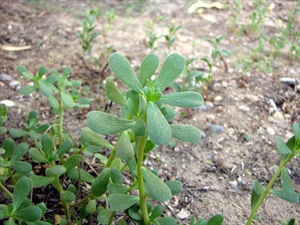Pigweed; it is also known as pig weed, or purslane.
Pacific Pests, Pathogens, Weeds & Pesticides - Online edition
Pacific Pests, Pathogens, Weeds & Pesticides
Pigweed (462)
Portulaca oleracea. It was known previously as Portulaca officinarum. It is a member of the Portulacaeae.
Asia, Africa, North, South and Central America, the Caribbean, Europe, Oceania. It is recorded from Australia, Federated States of Micronesia, Fiji, New Zealand, and Papua New Guinea.
There are several suggestions concerning the origin of pigweed. Waterhouse suggests the Americas, as it has more host-specific insects there compared with anywhere else. It is naturalised throughout the world.
A common weed of crops, pastures, gardens, disturbed sites, waste areas, footpaths and roadsides. In these situations, pigweed competes with many vegetables, grain and plantation crops; CABI's list includes: asparagus, red beets, celery, crucifers, cotton, maize, onions, potatoes, rice, soybeans, sugarcane, tomatoes and wheat. Pigweed is found from sea level to about 2500 masl.
Invasiveness of pigweed is assisted by large production of seed - up to a quarter of a million from one plant over a season is recorded in the USA (smaller numbers from the Philippines), and its ability to form flowers and high rates of viable seeds within a few weeks of germination. The seed survives in the ground for several years, but germinates rapidly following ploughing as it responds to light. This and its rapid growth means it has a competitive advantage over any crop growing at the same time. Also, it is drought tolerant, although it does best in moist, fertile soils.
Pigweed has a much-branched, creeping, fleshy stem, 20-50 cm long, often reddish, without hairs (Photo 1); stems do not produce roots in contact with the soil unless damaged. Leaves, alternate along stems, 5-25 mm long, 3-15 mm wide, hairless, wedge-shaped, without stalks (or they are very short) (Photo 2). Flowers, yellow, 4-6 petals (often 5), each 3-10 mm long, single or in small clusters, in the forks of leaves (Photo 3). There are 6-15 stamens (male parts) and a style (female part) with 3-6 branches. Fruits contain small black seeds, 0.5-0.6 mm across, glossy with a warty surface.
Spread is by seed. Seeds are spread long distances by wind, water, and by passing through the guts of birds. Pigweed can also be a contaminant of crop seeds.
One of the most successful weeds in colonising new areas. A weed of 45 crops in more than 80 countries. In the tropics, important in upland crops, such as peanuts, maize, rice, sorghum and sugarcane and vegetables. Depending on the crop, yield reductions of 20-40% are possible.
Pigweed is an alternative host of pests and diseases: nematodes (Meloidogyne incognita, Paralyenchus minutus, Rotylenchus reniformis, and Heterodera marioni); viruses of peanut, tobacco, beet, chilli, clover, and cucurbits (Cucumber green mottle virus, see Fact Sheet no. 422); and phytoplasma (aster yellows).
It is one of human being's early vegetables, and improved varieties with larger leaves are still eaten, raw in salads and cooked in casseroles, soups and pastries. On its own as a vegetable, it can be boiled or stir-fried. It is also a food for pigs. It has medicinal properties, for instance, as a diuretic, anti-inflammatory and as an antibiotic. It has high levels of omega-3 fatty acids, and vitamins A and C.
BIOSECURUTY
The risk of introduction is moderately high. It is a common weed, produces much seed and is invasive over a wide range of ecosystems. Countries not yet infested should consider all likely pathways for entry, and apply quarantine measures accordingly. Particular attention should be given to the risks associated with the weed as a contaminant of crop seed.
BIOLOGICAL CONTROL
Waterhouse lists three leaf-mining or gall forming flies, one leaf-mining moth, one leaf-mining sawfly, and three weevils as potential biocontrol agents. Further work is needed. One of the weevils, Hypurus bertrandi, which is restricted to pigweed, was introduced into Hawaii, but its present status is not reported.
CULTURAL CONTROL
- Physical & Mechanical
- Hand weed. Carry out before seed maturation.
- Hoeing. However, the plant is fleshy and resistant to desiccation, so it is difficult to control this way.
- Apply mulch. Add a layer of mulch about 8-10 cm deep to the bed to prevent seed germination.
CHEMICAL CONTROL
In Australia, a number of chemicals are registered, for instance: 2,4-D (check various formulations); diuron; dicamba; MCPA; metsulfuron-methyl; metribuzin; pendimethalin; propyzamide; fluroxpyr; trifluralin; glyphosate (and Fiji); oxyfluorfen.
--------------------
Note, EU approval to use glyphosate ends in December 2022; its use after that date is under discussion.
____________________
When using a pesticide, always wear protective clothing and follow the instructions on the product label, such as dosage, timing of application, and pre-harvest interval. Recommendations will vary with the crop and system of cultivation. Expert advice on the most appropriate herbicides to use should always be sought from local agricultural authorities.
AUTHORS Grahame Jackson & Aradhana Deesh
Adapted from Pigweed (Portulaca oleraceae) (2018) Weeds of SE Qld and Northern NSW. Lucidcentral. (https://www.lucidcentral.org/editors-pick-animal-and-plant-identification-keys/key-to-weeds-of-se-qld-and-northern-nsw); and additional information from CABI (2019) Portulaca oleraceae (purslane). Invasive Species Compendium. (https://www.cabi.org/isc/datasheet/43609); and from Waterhouse DF (1993) Portulaca oleraceae Linneaus. Biological Control: Pacific Prospects - Supplement 2. ACIAR Monograph No. 20. Canberra, ACT. Photo 1 Phil Westra, Colorado State University, Bugwood.org. Photo 2 ZooFari Portulaca oleraceae (Wikipedia). Photo 3 jacilluch Flower of Portulaca oleracea (Wikipedia).
Produced with support from the Australian Centre for International Agricultural Research under project HORT/2016/185: Responding to emerging pest and disease threats to horticulture in the Pacific islands, implemented by the University of Queensland, in association with the Pacific Community and Koronivia Research Station, Ministry of Agriculture, Fiji.






